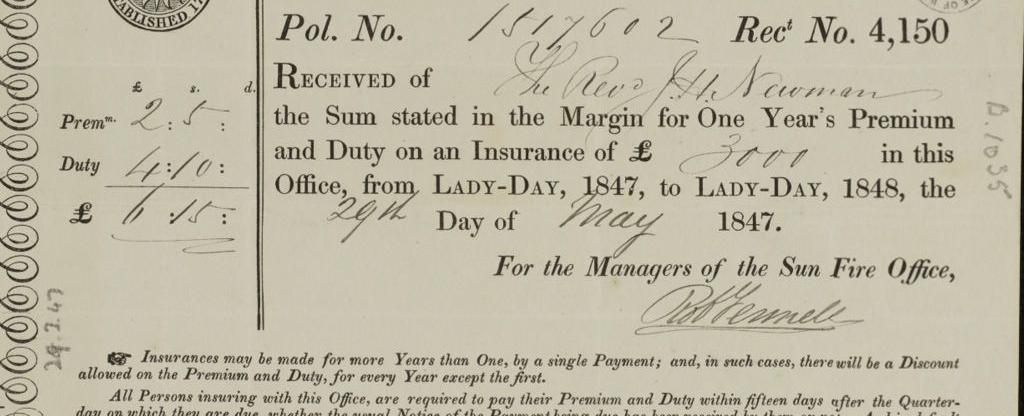A Collaborative Digitization Project between the National Institute of Newman Studies, Pittsburgh and the Birmingham Archdiocesan Archives, England

Project Overview
It was May 2018 when I first became aware of the National Institute of Newman Studies, having met the archivist, Lawrence Gregory at a Catholic Archives Society conference in High Leigh, Hoddeston, England. Over a congenial glass, or two, of whisky I learned about the Institute and the revolutionary digitization program they had embarked upon to secure and make accessible the letters of Saint John Henry Newman for academics around the world.
As an archivist, I was incredibly excited by the platform and conceptualization of access that NINS was creating, showing a forward-thinking vision that was almost unheard of at the time. By the end of the year, after numerous exchanges with Lawrence and hearing about the potential expansion of the project, it became clear that the Birmingham Archdiocesan Archives [BAA] should offer to be a potential collaborator, if suitable.
In November 2019, I was put in touch with Dr. Danny Michaels and in a brief email of introduction; I offered the institute access to any of the Newman papers we held, if of value to the project. The response was highly positive, and a meeting was set for early the following year with Professor Kenneth Parker when he was in England, which fortuitously took place before the world closed down with the Sars-Covid-19 pandemic. While access to the collections and the site was not possible, communications between the two organizations carried on apace. Comprehensive lists of the Newman letters and associated material the BAA held were sent to the team, while a contract was sent to the diocesan solicitor for approval. Amendments to the contract were made, and an expansion of the range of the material for digitization, to include some correspondence of Newman’s contemporaries and predecessors at the Oratory, were requested.
In the end, everything was set to go before access to the site in Birmingham was once more possible. The team at NINS were incredibly understanding of the restrictions in place and waited with patience until the BAA could fulfil its end of the project. In May 2021, the papers were finally accessible and were packed up and collected by the digitization firm from site, and six weeks later they were back and once more in safe storage at the BAA.
The project was, from the BAA side, a huge success, efficiently handled with professionalism and grace, not to mention good humour, by everyone at NINS. The most difficult thing to resolve was the contract of works, and that was only mildly problematic due to English law and the charitable status of the Archdiocese and not by any restrictions or requirements from the Institute. I cannot praise the hard work and commitment of the team enough.
Digitized Newman Material
If you type Newman into the BAA search engine, it will return 484 hits. Sadly, not all of these are letters to or from him, but all of them tell something of his story and the legacy he left behind. For the project, however, we focused on the letters held in the collection. The majority of the original material is split between three collections:
The B series contains over 12,500 documents that give testimony to the growth of the Church in the Midlands from the Emancipation. This series covers day-to-day administration, local interest (viz. the division of the country into eight Districts or Vicariates Apostolic in 1840), and the negotiations for the Restoration of the Hierarchy in 1850. Letters from Dr. Newman, Fr. Faber, the 16th Earl of Shrewsbury, Ambrose Phillipps de Lisle, and others illustrate the rapid strides the faith was making in the middle of the nineteenth century.
The R series is a collection that supplements the earlier A, B, C series. The provenance of most of the collection is unknown, with exceptions being the Newman/Braye Correspondence, the Newdigate Papers, and the Ilsley Papers. The correspondence between the then Cardinal John Henry Newman and Lord Braye comprises thirty-eight letters, dealing with matters of health and social intercourse, the vexed question of Catholics attending the Universities of Oxford and Cambridge (opposed by the English hierarchy until 1895), and diplomatic relations between Britain and the Holy See. The letters were published in The Letters and Diaries of John Henry Newman, volumes 28, 30, and 31 (OUP, 1975–1977) and were noted as belonging to the Canons Regular of the Lateran, St. Augustine’s, Datchet, Berkshire. It is not known when or by whom the letters were deposited at the BAA and the originals of two of the published letters (dated 12 February 1883 and “towards the end of April 1887?” the latter noted as “not sent”) are not in the present collection. The first of the letters was written by Newman before he was elevated to the cardinalate and before Braye assumed his title.
The Oscott [OCA/5/2/N] Subseries comprises three collections of material, which can be found in several volumes of The Letters and Diaries of John Henry Newman. The first collection [OCA/5/2/N/1/1] contains letters sent by Newman to the occupants of Baddesley Clinton House including Georgiana, Lady Chatterton, Edward Heneage Dering, Rebecca Dulcibella Ferrers [née Orpen], and Marmion Ferrers. The second collection [OCA/5/1/N/1/2] is correspondence to Bishop Ullathorne, Bishop Ilsley, Canon Estcourt, Canon Northcote, Canon Barry, and others, and the final collection [OCA/5/2/1/N/1/3] are letters to Elizabeth Anstice and James Spencer Northcote and were part of a gift to Oscott from the Dominican Sisters at Stoke, made in 1962.
In total, 413 letters to or from Newman were digitised and a further 30 letters to or from Newman’s fellow Oratorians were chosen and scanned to supplement the material.
Conclusion
When I approached NINS with the offer to access and digitize the material held at the BAA, it was not without an acute awareness that a large quantity of the material held at the archive has previously been made available to the public in The Letters and Diaries of John Henry Newman. Nevertheless, this is the first time the material can be viewed together with such ease, and I hope it will allow fresh insight and scholarship on this material to be possible.
It is with gratitude that I thank NINS for such a positive collaboration, allowing such open discourse and being prepared to not only create the digital content to preserve the collections in a new way but also to offer them up so freely for international scholarly access.
With this first chapter of work between the two institutions closed, I look forward to opening a new one with the possibility of making our Ullthorne, Ilsley, and Vaughan papers available to the Institute and thus the world.
Naomi Johnson
Curator-Archivist for the Catholic Archdiocese of Birmingham, England
Naomi Johnson is the curator-archivist for the Catholic Archdiocese of Birmingham, England. She graduated with a joint honors degree in Heritage Conservation and Architectural Conservation and a Masters in Collections Care. In 2013, she was appointed as Curator of the Catholic seminary, St. Mary’s College, Oscott, in Birmingham and in 2018 was appointed as Archdiocesan Archivist as well. Since 2018 she has been an active member of the Catholic Archives Society and in 2020, co-wrote a publication on Care of Artefact’s in Archives.
QUICK LINKS

